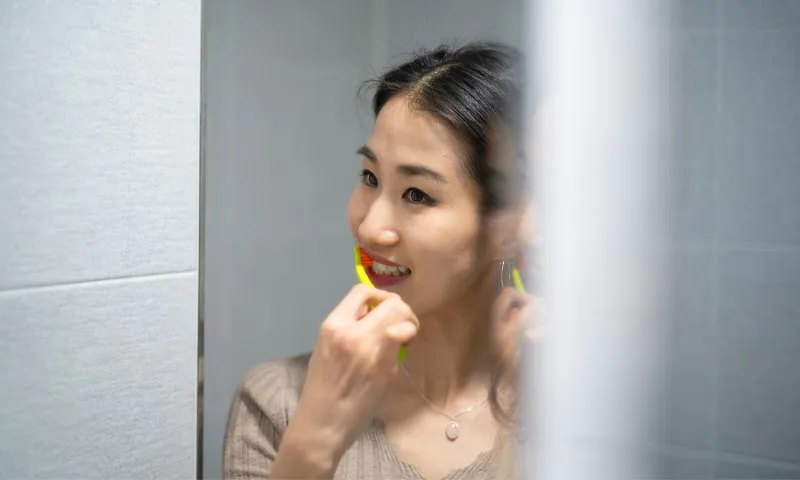Definition: What is a myofunctional disorder?
Myofunctional disorders (ICD-10 code F82.2) are defined as an imbalance of the muscles in the mouth and face area. This is also referred to as orofacial dysfunction or an orofacial disorder. Specifically, this means that the muscles of the lips and tongue are either too strong or too weak and the muscle tension in the mouth area is therefore not balanced.
This results in incorrect movement patterns: the mouth position is often open and "slack", which means that the tongue cannot take up its intended resting place on the palate. This leads to incorrect movements when swallowing. The tongue often pushes hard against the teeth, which can cause misalignment. Myofunctional disorders also have a negative impact on speech and ensure that those affected breathe predominantly through their mouth.
Frequency
Myofunctional disorders usually become apparent in childhood, but can also occur in adults. The muscle disorder is very common in children. In a study conducted by the University of Rostock, scientists examined 3041 children - 766 of them in their primary dentition and 2275 in the mixed dentition phase. 39 per cent of children with milk teeth and 43 per cent of children with mixed dentition had their mouths open all the time. Similar figures were also available for an unusual tongue resting position (34 per cent for milk teeth and 42 per cent for mixed dentition).
Causes: What causes a myofunctional disorder?
There are a number of possible causes for the development of a myofunctional disorder. As a rule, the disorder cannot be attributed to a single factor. Rather, it is a combination of many different factors that are often both a symptom and a cause.
Disorders during pregnancy and birth
When and how a baby is born can have a significant influence on the development of the facial muscles. Problems during pregnancy or birth can trigger myofunctional disorders. These include a lack of oxygen, premature birth, low birth weight (under 1500 grams) and various birth defects.
Genetic factors
Various syndromes such as trisomy 21 (also known as Down syndrome), Pierre Robin syndrome, but also cleft lip and palate or a shortened tongue tie can lead to myofunctional disorders. Mothers of babies with a shortened tongue tie almost always have breastfeeding difficulties, which very often leads to the infant having to be bottle-fed. Unfortunately, this has been little known in the professional world to date, which is why midwives often try - unfortunately unsuccessfully - to treat the mother. The birth defect can be corrected with a minor operation that is hardly painful for the baby and protects the child from the long-term consequences of a myofunctional disorder.
Unfavourable nutrition in infancy
Speaking of breastfeeding: It is generally recognised that breast milk is the best infant formula. However, if breastfeeding is not possible or a baby has only been breastfed for a short time, this can favour the development of a myofunctional disorder - especially if the bottle has too small a lip rest and too large a teat hole. As a result, the baby trains an unfavourable swallowing pattern.
If infants are given food in porridge or liquid form for too long and therefore do not train their chewing muscles sufficiently, there is also a risk of myofunctional disorders.
ENT problems
If children cannot breathe through their nose, they are forced to breathe through their mouth and keep their mouth open at all times. Reasons for this include frequent colds, middle ear infections, allergies, swollen tonsils or allergies.
Misaligned teeth
Misaligned teeth such as an open bite or crossbite can favour myofunctional disorders. However, the myofunctional disorder can also be the cause of these malocclusions because the tongue presses on the teeth when swallowing incorrectly. With an open bite, the upper and lower jaws do not rest on each other when biting down; instead, a gap forms between the upper and lower row of teeth. If there is already an open bite, children often begin to lisp because they press their tongue into the gap between the upper and lower jaw when speaking.
Good to know:
The most common jaw misalignment is the open bite. You can find out what causes it and how it can be treated in our article:
Overload
Children need sufficient periods of rest in everyday life. If they are unable to rest and are exposed to constant overstimulation, a myofunctional disorder can also develop due to psychological stress and excessive demands.
Functional and motor causes
Poor head and body posture as well as motor disorders can also favour a myofunctional disorder. This also includes breathing through the mouth, which on the one hand leads to less oxygen intake and on the other hand has a negative impact on the facial muscles and even the development of the jaw and facial bones.
Bad habits
Habits are harmful habits that can trigger or exacerbate an imbalance in the mouth and facial muscles. Habits that favour a myofunctional disorder include thumb sucking, nail biting, lip biting, cheek and lip sucking and constant sucking on a dummy.
Good to know:
Choosing the right dummy is an important decision: While an ergonomic model has a positive influence on the development of the palate, non-ergonomic models can cause great harm. Here you can find out what to look out for:
Symptoms: How does a myofunctional disorder manifest itself?
In myofunctional dysfunction, as already mentioned, there is an imbalance between the outer and inner mouth muscles. If certain muscles are too strong or weak, the other muscles try to compensate for the imbalance. This can lead to the following symptoms:
- Constantly open mouth
- Incorrect resting place of the tongue (tongue often between or on the teeth and does not lie against the palate)
- Tongue clenching (tongue presses against the teeth when swallowing)
- Partially too short, shortened upwards upper lip and lower lip rolled outwards
- Mouth breathing
- Tension in the facial muscles
- Rejection of hard food and difficulty chewing (too much saliva, chewing with open mouth, insufficient crushing)
- Strong salivation in infants
- Indistinct speech due to forward displacement of the tongue, little lip movement when speaking
- Sigmatism (lisp)
- Restricted mobility of the tongue
- Snoring or loud breathing at night
- Moist, shiny and often thickened lips
- Rash at the corners of the mouth
- Tooth marks on the tongue
- Habits (as described above)
- Misaligned teeth and unfavourable development of the jaw bones
- Delayed change of teeth
- Lengthening the growth of the face
- High, narrow palate
- Frequent infections in the ear, nose and throat
- Tired appearance
- Stooped, "limp" posture
- Reduced receptivity and lack of concentration
Several symptoms are often interrelated and favour each other. For example, an open mouth posture favours mouth breathing, which in turn leads to an incorrect resting position of the tongue. Another example: If the lip muscles are too weak, the lips open and there is a lack of mouth closure. This means that the negative pressure required for physiological swallowing cannot be created in the oral cavity. To compensate for this, the tongue presses against the teeth, which in turn can cause misaligned teeth.
Consequences: What happens if a myofunctional disorder is not treated?
Myofunctional disorders affect the development of the affected child in many ways. If the muscle disorder is not treated, it often leads to misaligned teeth and speech disorders - especially lisping. Breathing through the mouth, which those affected generally prefer, also has many disadvantages: On the one hand, children who breathe through their mouths are more likely to contract nasopharyngeal infections because the inhaled air is not filtered through the nose. On the other hand, there is a greater risk of tooth decay, as more bacteria can enter the mouth and the protective function of saliva is not guaranteed when the mouth is dry and open.
What many people don't realise: The way in which children breathe has a major influence on the development of their face and jaw shape. While children who breathe through their nose generally have defined cheekbones, straight noses and straight teeth as well as a wider, more harmonious face shape later on, children who constantly breathe through their mouth develop a rather elongated face with undefined cheekbones, crooked noses and often misaligned teeth. This is due to the fact that the tongue cannot take up its resting place on the palate when the mouth is constantly open and the impulse for growth in width is therefore lacking at this point. This is why children who suffer from a myofunctional disorder often have a narrow, high palate.
Good to know:
With the right breathing technique, you can take in 20 per cent more oxygen, lower your blood pressure and increase your concentration. We'll tell you how to do this in our article:
If a myofunctional disorder is not treated in childhood, it can develop into craniomandibular dysfunction (CMD). This is also an imbalance - but it also involves the jaw bones and temporomandibular joints. CMD creates a spiral of tension that runs through the entire body and can cause ear, head and back pain and even problems with the intervertebral discs.
You can find out how to treat your craniomandibular dysfunction in our article:
Diagnostics: How is a myofunctional disorder diagnosed?
Unfortunately, myofunctional disorders are not recognised by many doctors, even if you attend all the scheduled check-ups with your child. If you notice any of the symptoms listed, you should make an appointment with a dentist, orthodontist or ENT doctor as a precaution. In a detailed medical history interview, the doctor will identify possible causes and harmful habits. The oral cavity is then thoroughly examined. The doctor will also check to what extent the muscles involved in the swallowing process are functioning normally.
If you have been diagnosed with a myofunctional disorder, you will usually receive a prescription for speech therapy or be referred directly to a myofunctional therapist. For children, therapy is usually covered by health insurance - adults often have to make an additional payment towards the costs.
Treatment: Myofunctional therapy
The good news first: myofunctional disorders can be cured. Daniel Garliner developed "myofunctional therapy" in 1964 as a treatment. Fixed components of this therapy are the correction of the tongue resting position through various exercises, swallowing exercises, exercises to strengthen the muscles and also a correction of breathing. In children, these exercises are often performed as games. Over time, the concept has been expanded by various therapists.
If you are wondering at what age such therapy makes sense, there is a clear answer: as early as possible. As soon as the symptoms described above appear, children can start therapy to minimise the consequential damage.
According to the dentists' catalogue of remedies, up to 30 units of speech, language and swallowing therapy can be prescribed. The duration of therapy varies depending on the severity and the number of therapy sessions required.
In addition to logopaedic therapy, myofunctional therapy often involves parallel orthodontic treatment to correct misaligned teeth. The aim of functional therapy is to permanently resolve the muscle imbalance. Osteopathy also offers healing approaches for myofunctional disorders.
How to prevent a myofunctional disorder: 4 tips
To prevent a myofunctional disorder from occurring in the first place and also to maintain the success of the therapy, you can actively train the mouth and facial muscles with your child. We have collected some helpful tips for this:
Chew solid foods
It is important for the healthy development of the oral-facial muscles and also the bones in this area that children chew solid food regularly. From the age of six months, children can be introduced to solid foods in order to move from the sucking-swallowing pattern to the chewing-swallowing pattern. Offer your child different types of hard food - for example nuts, carrots, apples or crusty bread. Caution: Your child should not eat whole nuts until they are five years old, otherwise there is a risk of choking.
Chew gum
Chewing gum trains the chewing muscles and is great fun for children. When choosing the right chewing gum, however, make sure that it is sugar-free and ideally contains xylitol - this natural sugar substitute is good for dental health and protects against tooth decay (for example, the 'Black is White' chewing gum from Curaprox).
Playfully train your muscles
There are lots of activities that are fun for children and train their facial and mouth muscles at the same time. These include sucking, blowing and tongue movements of all kinds: from blowing soap bubbles, whistling and blowing cotton wools, to sucking in spaghetti and drinking with a straw, to making faces and licking a spoon.
Promote nasal breathing
You already know that nasal breathing is very important for the correct development of facial and jaw bones in children. It is therefore important to pay attention to whether your child breathes through the nose or the mouth. In addition to speech therapy, in which your child learns exercises for correct breathing, there are also aids for everyday life: special mouth plasters can be stuck around the child's lips to keep the mouth closed. This prevents the child from breathing through their mouth and they breathe automatically through their nose. Before using such plasters, however, you should check with your paediatrician whether your child can breathe through their nose without any problems.
Use an ergonomic soother
Babies find sucking on a dummy soothing. Unfortunately, many dummy models are not ergonomically shaped and therefore lead to unfavourable development of the jaw, palate and teeth. If you use a conventional dummy, you should only use it sparingly. It is better to opt for a biofunctional soother that has a positive influence on your baby's development.
Good to know:
The biofunctional soother from Curaprox supports the optimal natural development of the jaw, teeth and palate and ensures that your baby breathes through the nose right from the start. It is of course also free from harmful substances.
Sources
CMD-Arzt.de: Myofunctional therapy.
Physio Balance Health Centre: Myofunctional disorder.
Deutscher Bundesverband für Logopädie e.V.: Orofacial myofunctional disorder (OMS).
German Society for Phoniatrics and Paediatric Audiology: What are myofunctional disorders or orofacial dysfunctions and what do they have to do with my child's hearing and speech development?
Deutsche Gesellschaft für Sprachheilpädagogik e.V.: Myofunctional disorders.
Gesund.bund.de: F82.2: Circumscribed developmental disorder of oral motor skills.
Grabowski, R. et al.: The open mouth posture in childhood - frequency and consequences, in: Information from Orthodontics & Orthodontics. 2008.
Huber, Bettina: Myofunctional therapy, at: mft-therapie.ch.
Institute for Specialised Systemic Therapy: Myofunctional Therapy.
Kassenzahnärztliche Vereinigung Land Brandenburg: Heilmittelkatalog Zahnärzte, Maßnahmen der Sprech-, Sprach- und Schlucktherapie.
Lange, BIrgit: Myofunctional disorders, at: birgit-lange.de.
Logopaedie.com: Habits.
Upper Swabia speech therapy network: Myofunctional disorder.
Peter, Sabine: Myofunctional therapy, at: myofunktionelle-therapie.ch.
Praxis für Logopädie A. Kittel: Swallowing screening according to A. Kittel and N. Förster.
Redding-Jopp, Frauke: Muscular imbalance of the facial and swallowing muscles: myofunctional disorder, at: logopaedie-jopp.de.
Simma-Kletschka, Irmgard: Myofunctional aspects in orthodontics, in: Zahn Krone.
Theralingua: Lisp / Sigmatism.
Wagner, Julia: When are children allowed to eat nuts? You should pay attention to this, on: praxistipps.focus.de.
All websites last accessed on 01/02/2024.
 Swiss premium oral care
Swiss premium oral care








